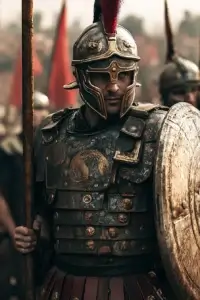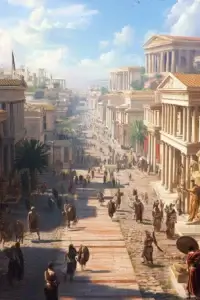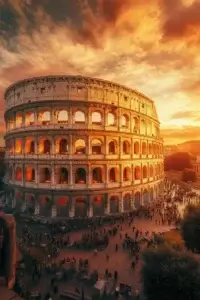
The Roman Empire is one of the most fascinating civilizations in human history. Its influence spread across three continents and lasted for over a millennium, shaping the course of Western civilization. From its military prowess to its contributions in law, language, and architecture, the Roman Empire’s achievements continue to resonate in modern society. This article explores the top achievements of the Roman Empire, delving into their lasting impact and how they continue to shape the world today.
The Vast Roman Empire: A Superpower That Spanned Centuries
One of the most remarkable achievements of the Romans was the sheer size and longevity of their empire. Spanning over 1,100 years, from 625 BC to AD 476, and even longer if one includes the Eastern Roman Empire (Byzantine Empire), which lasted until AD 1453, the Roman Empire covered vast territories across Europe, Asia, and Africa.
At its height, the Roman Empire encompassed the Mediterranean basin, stretching from the British Isles in the northwest to Egypt in the southeast, and from the Iberian Peninsula in the west to the Mesopotamian plains in the east. This vast expanse allowed for the exchange of cultures, goods, and ideas, laying the foundation for what would later become the Western world.
The Roman Army: Masters of Military Strategy

The Roman Army was a formidable force that played a crucial role in the expansion and maintenance of the empire. Known for its discipline, organization, and innovative tactics, the Roman Legion was perhaps the most powerful military force of its time. Despite not having access to modern technology like airplanes, tanks, or battleships, the Roman soldiers were masters of warfare, capable of defeating much larger armies equipped with similar weapons.
The Roman military was not just about brute force; it was a well-oiled machine that combined strategy, engineering, and logistics to dominate its enemies. The construction of roads, forts, and fortifications ensured the rapid movement of troops and supplies across the empire, while the development of advanced siege techniques allowed the Romans to conquer heavily fortified cities.
Founding Fathers of Modern Cities: The Roman Urban Legacy

The Romans were not only conquerors but also builders and urban planners. They founded numerous cities across Europe, many of which still stand today. London, for example, was established by the Romans as Londinium, and Cologne was founded as Colonia Agrippina. The legacy of Roman urban planning can be seen in the grid-like layouts, public squares, and infrastructure of these ancient cities.
Roman cities were designed with functionality and grandeur in mind. They featured forums, temples, baths, amphitheaters, and aqueducts, many of which have survived to this day. The Roman emphasis on public spaces and infrastructure laid the groundwork for modern urban planning, influencing the development of cities throughout Europe and beyond.
Master Builders: The Architectural Marvels of Rome
No civilization is as closely associated with construction and architecture as the Romans. Their engineering prowess is evident in the numerous structures they left behind, many of which are still in use today. Roman aqueducts, for instance, were engineering marvels that transported water over long distances, supplying cities with a reliable source of fresh water. Some of these aqueducts, like the Pont du Gard in France, are still standing, a testament to the durability and ingenuity of Roman engineering.

Roman roads, another significant achievement, were essential for the administration and defense of the empire. These roads, built with layers of materials to ensure longevity, connected even the most remote provinces to the heart of the empire. Many of these roads are still in use today, serving as the foundation for modern road networks in Europe.
Roman amphitheaters, such as the Colosseum in Rome, are among the most iconic structures of the ancient world. These massive arenas hosted gladiatorial games, public spectacles, and other forms of entertainment, drawing thousands of spectators. The Roman use of arches, vaults, and concrete revolutionized architecture, allowing for the construction of large, durable structures that have withstood the test of time.
Latin: The Eternal Language
As the Roman Empire expanded, so did its language—Latin. Latin was the lingua franca of the Roman military, administration, and culture, spreading across the vast territories of the empire. Even after the fall of the Western Roman Empire, Latin continued to be used as the language of scholarship, law, and the Catholic Church.
The influence of Latin is still felt today in the Romance languages, including French, Italian, Portuguese, Romanian, and Spanish, all of which evolved from Latin. Additionally, Latin has had a significant impact on the English language, contributing a substantial portion of its vocabulary, particularly in the fields of law, science, and medicine.
Latin’s legacy extends beyond language; it also influenced the development of the Roman alphabet, which is still used in most of the Western world today. While the alphabet has undergone some modifications, such as the addition of the letter “W,” it remains largely the same as it was in ancient Rome.
Roman Law: The Foundation of Modern Legal Systems
One of the most enduring legacies of the Roman Empire is its legal system. Roman law laid the foundation for many of the principles of justice and governance that we take for granted today. The Romans were among the first to codify their laws, creating a comprehensive legal system that applied to all citizens.

The Twelve Tables, created in 451 BC, were the first examples of written law in Rome. These bronze tablets laid down the basic rights and duties of Roman citizens, establishing a legal framework that governed everything from property rights to criminal justice. The concept of equality before the law, which is a cornerstone of modern legal systems, has its roots in Roman law.
Later, Emperor Justinian I compiled and refined Roman laws into what is known as the Justinian Code. Completed in AD 529, the Justinian Code became the foundation for the legal systems of many European countries and continues to influence legal thought to this day. The principles of Roman law, such as the presumption of innocence and the right to a fair trial, remain central to modern jurisprudence.
Roman Religion: A Pantheon That Shaped Western Beliefs
The religious practices of ancient Rome had a profound impact on the spiritual life of the empire and its successors. The Romans were polytheistic, worshipping a pantheon of gods and goddesses who were believed to control various aspects of life and nature. Many of these deities were borrowed from Greek mythology, but the Romans added their own interpretations and rituals.
The spread of Roman religion throughout the empire helped to unify the diverse cultures within its borders. Temples dedicated to Roman gods were built in cities and towns across the empire, and religious festivals became important communal events. The Roman practice of deifying emperors also reinforced the authority of the imperial government, intertwining religion and state.
With the rise of Christianity in the later years of the empire, Roman religious traditions began to evolve. Christianity, which started as a small Jewish sect in the eastern provinces of the empire, eventually became the dominant religion in the Roman world. The conversion of Emperor Constantine to Christianity and the subsequent Edict of Milan in AD 313, which granted religious tolerance to Christians, marked a significant turning point in Roman religious history.
The adoption of Christianity as the state religion under Emperor Theodosius I in AD 380 had far-reaching consequences, leading to the decline of traditional Roman religion and the rise of the Catholic Church. The structure and organization of the Church were heavily influenced by Roman administrative practices, and the Pope, the leader of the Catholic Church, still bears the title of Pontifex Maximus, a title that was originally used by the chief priest of Roman religion.
The Roman Economy: Trade, Currency, and Innovation
The Roman Empire’s economy was one of the most advanced of its time, characterized by a complex system of trade, a stable currency, and numerous innovations that facilitated economic growth. The vast network of Roman roads and maritime routes allowed for the efficient movement of goods and people across the empire, fostering trade and cultural exchange.
Roman currency, based on the silver denarius, was widely accepted throughout the empire, providing a stable medium of exchange that facilitated commerce. The standardization of currency, weights, and measures helped to integrate the diverse economies of the empire, creating a single economic system that spanned three continents.
The Romans were also innovators in agriculture and industry. They developed advanced techniques for farming, irrigation, and animal husbandry, which increased agricultural productivity and supported the growing population of the empire. Roman engineers built aqueducts to supply water to farms and cities, and they constructed mills, mines, and workshops that produced goods for domestic use and export.
The Roman economy was not without its challenges, however. The empire’s reliance on slave labor, combined with the high cost of maintaining its vast military and administrative apparatus, eventually contributed to economic decline. Nevertheless, the economic achievements of the Roman Empire laid the foundation for the development of the medieval and modern economies of Europe.
The Roman Legacy: A Civilization That Shaped the World
The achievements of the Roman Empire are numerous and far-reaching. From its military conquests and architectural marvels to its legal innovations and cultural influence, the legacyof Rome continues to shape the world today. The Roman Empire was not just a political entity; it was a civilization that left an indelible mark on history. The Roman Empire’s contributions to law, language, architecture, and urban planning continue to influence modern society. The principles of Roman law are embedded in the legal systems of many countries, and the Roman alphabet remains the standard writing system in the Western world. The Romance languages, spoken by hundreds of millions of people, are direct descendants of Latin, the language of the Romans.
Roman engineering and architecture have inspired countless generations of builders and architects. The use of arches, vaults, and concrete, pioneered by the Romans, revolutionized construction and made it possible to create structures of unprecedented size and durability. Many of the roads, aqueducts, and buildings constructed by the Romans have survived for millennia, serving as enduring symbols of their engineering genius and artistic vision.
Roman Influence on Western Culture and Society
Beyond the physical and legal contributions, the Romans also had a profound impact on Western culture, philosophy, and education. Roman literature, philosophy, and rhetoric were heavily influenced by Greek culture, but the Romans made these traditions their own, adapting and expanding them in ways that have influenced Western thought for centuries.
Roman Literature and Philosophy
Roman literature, including the works of Virgil, Ovid, and Cicero, continues to be studied and revered for its eloquence, depth, and insight into the human condition. Virgil’s Aeneid, for example, not only glorified Rome’s origins but also became a cornerstone of Western literary tradition. Cicero’s philosophical and rhetorical works provided a foundation for the study of ethics, politics, and oratory, influencing thinkers from the Renaissance to the modern era.
The Roman philosophy of Stoicism, which emphasized reason, self-control, and virtuous living, has also had a lasting impact. Figures like Seneca, Epictetus, and Marcus Aurelius articulated ideas that have shaped ethical and philosophical discourse throughout Western history. The Stoic belief in universal human dignity and the importance of rational thought continues to resonate in contemporary discussions on ethics and personal development.
Roman Education and the Spread of Knowledge
The Roman approach to education, which emphasized rhetoric, grammar, and philosophy, was designed to prepare citizens for public life. This emphasis on a well-rounded education influenced the development of the liberal arts tradition, which remains a cornerstone of modern Western education. The Romans also established libraries and centers of learning throughout the empire, facilitating the spread of knowledge and the exchange of ideas.
Roman contributions to education were not limited to philosophy and rhetoric; they also made significant advancements in fields such as medicine, engineering, and law. The writings of Roman medical experts like Galen, for example, were studied for centuries and formed the basis of medical knowledge in both the Islamic world and medieval Europe.
The Fall of the Roman Empire: A Transformation, Not an End
While the Western Roman Empire officially fell in AD 476, the legacy of Rome did not end with its collapse. The Eastern Roman Empire, or Byzantine Empire, continued to thrive for nearly another thousand years, preserving and transmitting Roman culture, law, and traditions.
The fall of Rome was not a sudden event but rather a gradual transformation. The institutions, culture, and ideas of Rome continued to evolve and influence the medieval world. The Catholic Church, which became a dominant force in Europe after the fall of the Western Empire, was deeply rooted in Roman traditions, both religious and administrative. The Church played a crucial role in preserving Roman law, philosophy, and education, ensuring that the Roman legacy would endure.
The Roman Empire’s influence can also be seen in the development of the Holy Roman Empire, a political entity that sought to revive the glory of Rome in medieval Europe. Although it was neither holy, Roman, nor an empire in the traditional sense, it represented the continuation of Roman ideals of governance and unity.
Conclusion: The Timeless Legacy of Rome
The Roman Empire’s achievements are unparalleled in their scope and impact. From the vastness of its territory and the power of its military to its innovations in law, architecture, and culture, Rome laid the foundations for much of what we consider Western civilization today.
The Roman approach to governance, law, and urban planning has influenced countless societies and continues to be relevant in modern discussions of government, justice, and city development. The spread of Latin and the Roman alphabet helped shape the languages and literatures of Europe, while Roman engineering and architecture set standards that are still admired and emulated.
The Roman Empire was not just a historical entity; it was a crucible of innovation, culture, and power that forged many of the elements that define the modern world. As we look around at the cities we live in, the languages we speak, the laws that govern us, and the philosophies that guide our lives, we can see the enduring legacy of Rome in every aspect of Western civilization. The story of Rome is not just a story of the past; it is a continuing narrative that lives on in the very fabric of our contemporary world.
